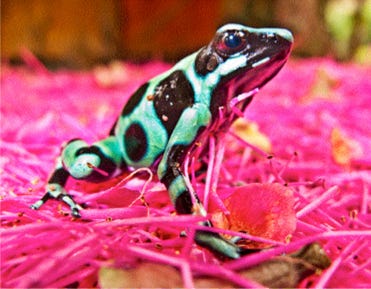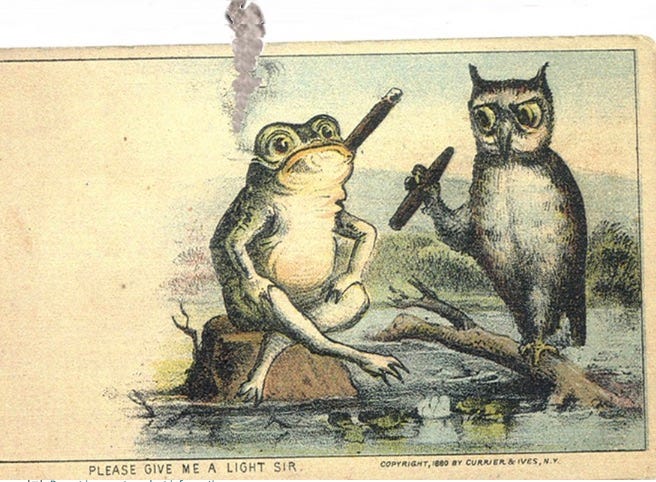THE GREATEST SECOND-CHANCE FROG QUEEN (Part 5)
Some startling "War Facts" that humans have created since the Civil (un-civil) War, and to modern times. And how us frogs aid your medicines & space travel! https://www.amazon.com/dp/B09QML8BQN
“I’m a little embarrassed to say” (says Frog Queen Gertrude), “that some frogs devour other frogs!” How can one frog eat another? I guess we’re just like human cannibals who eat other humans? I know it’s frowned upon in human cultures, so it’s not very uplifting to have to admit this. My only defense is, that’s just nature’s way. But few humans would admit that cannibalism is also nature’s way. Isn’t that true?
Getting back to the inter-species killing of humans versus frogs, it continues to be surprising that within a certain group there can be such a high level of disharmony. It’s not as if, in the entire planet, humans don’t have enough resources to stretch out and make each and every individual happy, from being well fed to well sheltered. What exactly has gone wrong?
With inventions like John Kay’s flying shuttle (circa 1733) for faster weaving = production of clothes and blankets, to the ‘combine’ by Hiram Moore, in 1834, for faster harvesting of crops = more food, the humans have worked tirelessly to produce more basic needs, faster, at lower costs. The catch is that all these amazing contraptions — in modern days; lasers, rocket ships, nuclear power, electric cars, medicines for the worst diseases, even GMO foods to bypass usual downturns in farming seasons, plus better/cheaper materials for house and skyscraper construction — HAVE NOT HELPED. There have been more human wars, right up to the present, using equally-creative technological breakthroughs to kill more people, faster, with improved delivery systems.
Case in point. When we frogs have enough bugs floating to the surface of the pond, enough attractive female counterparts to happily procreate, nice weather for sitting atop a lily pad, and decent temperature water to duck under to cool off, we don’t race around killing the nearest frog even if their green exterior is a bit darker than ours.
And if we do kill, we usually eat the loser, which seems pretty ecological after what we know about you humans. Oh, maybe I should add some casualties figures from the 20th century human wars — it’s a nice list, just to rub salt in the wound a bit.”
WWI (1914-18)— 18,000,000 killed. (that’s 11 million military, 7 million innocent bystanders, civilians who were just trying to survive!). And 23,000,000 wounded as well (ouch!).
WWII (1939-45) — 60,000,000 killed (or as the statisticians say, anywhere between 50-80 mil.). Not worth using an exclamation point, is it? Anyway, about 3% of the total world population (now I must — !).
So, there’s the early-to-mid-century meltdown of people just trying to ‘get along.’ While frogs in all these countries around the world were hopping around, humans were using every new-fangled invention they could gather up to kill or maim each other. Not a pretty (or hopeful) picture.
But there’s numbers that mean even more to the men and women who served in past combat, like in the mid-1800s. In the US civil war (1860-65) death toll was one-in-four. That is probably why even today there are lasting grudges, lasting conflict from north to south, generations of families wanting to either tear down confederate statues or erect new ones. Everyone was totally and personally affected in that war, sometimes brother fighting against brother.
Frogs have no weapons. Frogs have no vehicles. Or houses, unless you count overhangs and bushes. We have no machines, no phones, computers, no nuclear bombs or reactors. Our puny-and-puffy little hands aren’t really built to clamp down on weapons. We can hardly clutch anything. I have seen an image of a frog smoking a cigar, but that’s obviously a human cartoon, trying to insert human characteristics in members of the amphibian and animal kingdom. That usually doesn’t bode very well, if it’s the truth you’re after.
Frogs don’t have hands. We have ‘pads,’ that are great for sticking to things like trees (rough surfaces), lily pads (smooth surfaces), and just about anything you’ve got.
Scientists have actually spent some time looking into our secret ’stickiness,’ and here’s what they’ve found out. We have ‘self-cleaning’ for our hand and feet pads, and we produce ‘mucus’ to keep them sort of moist.
The toe-pads in our hands (yes, I realize that they should be called ‘hand-pads,’ but the scientists want to believe all we have are toes...), are made up of extremely complex cells, ‘special cells’ say those investigating humans, which can wiggle in and grab in crevices, or get the most suction when dealing with surfaces as smooth as glass. We are amazing in this regard, aren’t we?
So some real money in the human scientific community has been spent on looking into our hands and feet toe-pads. In Scotland, researchers used an Atomic Force Microscope (AFM) to examine the tiny parts of our pads, checking out our White’s tree frog brothers at a billionth of a meter, to see how her pads could be so adhesive. They discovered some hexagonal cells with groves around the outside of each one, filled with that mucus like I mentioned. And the tops of the cells that made contact with things were not flat, but had ‘nanopillers’ with little dimples on each one. Funny sounding name, I know, but there was real power in this surface that no human eye could see without a microscope.
The latticed structure in our nanopillered pads have led researchers in this area to develop applications in solar panels, bacteria-resistant surfaces, and even helping organ implants to better adhere to tissue in the donors while shedding harmful bacteria.
Scientists at Lawrence Berkeley National Lab in California are using nanopillered -based structures to develop miniaturized tin-graphene batteries that charge quickly in ten minutes and and store 700 hours per gram of charge (important for new solar cars, space exploration, and everything I guess). Hard to imagine that graphene comes in one-atom thick sheets, and that our frog-inspired nanopillered technology is even helping with computers, where the heat coming off the electrical circuits must be better managed for fast, low-heat transistors.
All sorts of interesting things are being developed that can aid humans in living better, just because they got interested in our little toes! So I guess we frogs can be pretty proud of ourselves.
Red-eyed tree frogs have survived for 10 million years!
————-
The Queen Gertrude thinks this should be enough intense scientific data for one little froggie posting! Next comes her “Listen To Your Elder’s” rant. If we frogs can count 10 Million years OF EXISTENCE, then maybe humans should spend a second or two checking it out. —
And why wait for Rick to post them? Get the full hold-in-your-human-hands book instantly here (a perfect stocking-stuffer): https://www.amazon.com/dp/B09QML8BQN








